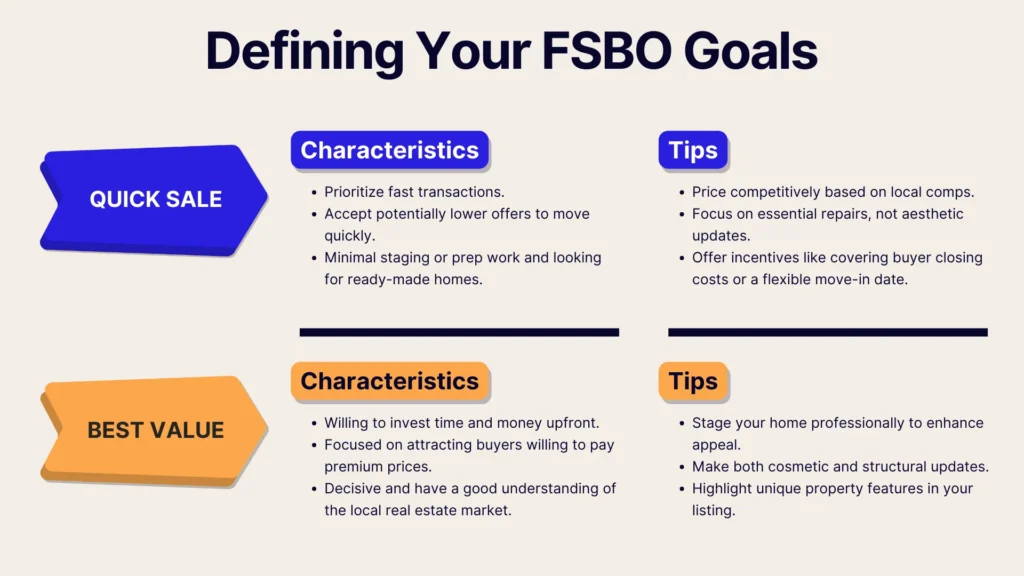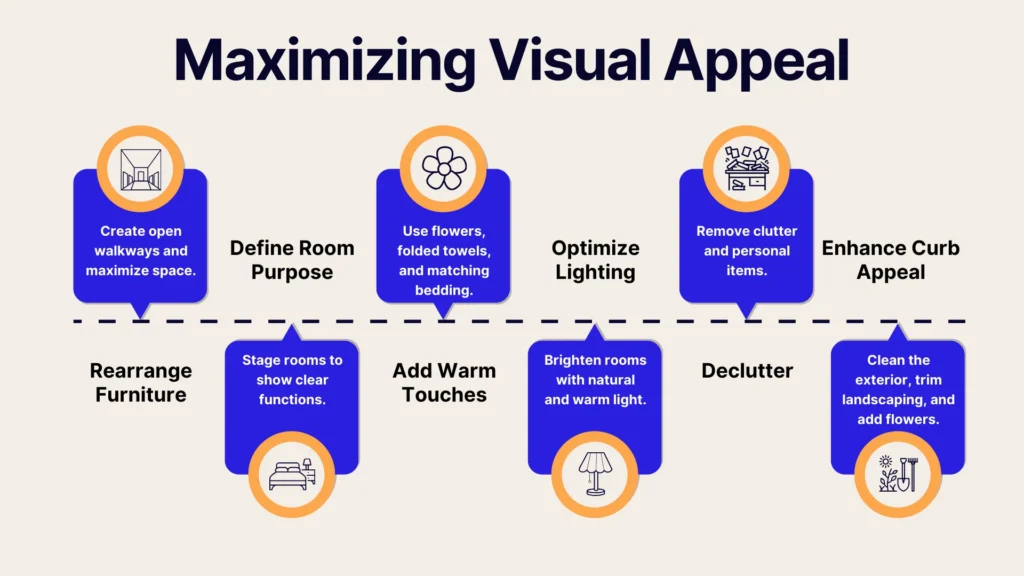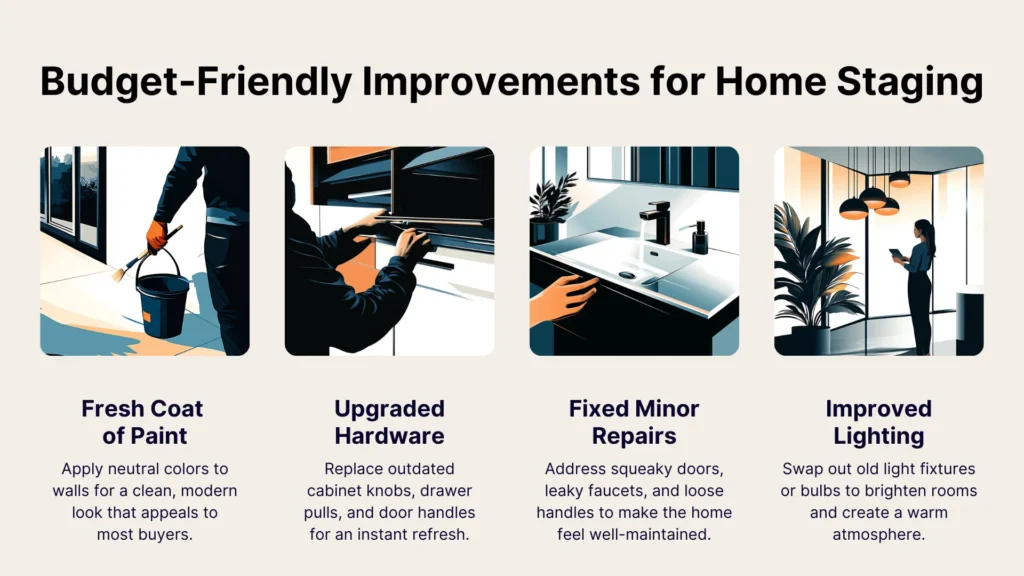Selling your home on your own can seem fairly straightforward, but before you even get to signing a contract with a buyer, you’ll need to prep your home for sale. Unless you’re willing to sell your home exactly as-is (and potentially have to settle for a much lower price), you need to take steps to make your home look its best and repair potential areas of concern.
Don’t neglect this stage, as properly prepping your home before listing can help attract serious buyers, streamline the process, and even boost your sale price. Keep reading this guide to learn all about the essential steps of prepping your home prior to its sale, from planning your sale to organizing critical documents.
Planning Your FSBO Sale
Before you hang that “For Sale” sign, it’s essential to have a plan in place. Here’s how to get started:
- Setting Clear Goals: First, ask yourself why you are selling and what you want to achieve. Are you looking for a quick sale or focused on getting top dollar? Define your goals upfront to guide your decisions throughout the process.
- Defining Your Timeline: Timing matters when selling a home. Start by deciding on your ideal listing date and desired closing timeframe. Once under contract, the average home sale takes 30 to 60 days. If you’re selling during a hot real estate season—like spring or early summer—you may need to act quickly to prepare your home. Conversely, slower seasons might give you more time to get everything ready.
- Understanding Your Local Real Estate Market: Take the time to research your local market. Look at comparable homes (“comps”) in your area to understand pricing trends. What are homes like yours selling for? Are properties moving quickly, or is the market slow? Knowing the answers to these questions will help you price your home competitively and set realistic expectations.

Gathering Essential Documents
Buyers want to feel confident about their purchase, and providing the proper documentation can make all the difference. Here’s what you’ll need:
- Title Deed and Property Records: Gather the deed to your home and any property records that show ownership history. Buyers will want proof that you own the house and have the legal right to sell it.
- Utility Bills and Repair History: Transparency is key in an FSBO sale. Collect recent utility bills to give buyers an idea of what they can expect to pay for water, electricity, gas, etc. List any repairs or upgrades you’ve made over the years, such as a new roof, HVAC system, or kitchen renovation. Highlighting these improvements can help justify your asking price.
- Other Documentation Buyers May Request: Prepare to provide other essential documents, including:
- Homeowner Association (HOA) Information (if applicable): Include rules, fees, and contact information.
- Mortgage Payoff Statement: Buyers might want to see this to ensure a clean transfer of ownership.
- Home Inspection Report: If you’ve had an inspection done recently, it’s a great way to instill confidence in buyers.
- Floor Plans and Survey Documents: These give buyers a clearer understanding of the property layout and boundaries.
Decluttering and Organizing
A clean, organized home photographs better and feels more inviting to potential buyers. Follow these steps to make your space shine:
Decluttering Your Space
Start by identifying items to remove or store. Focus on areas where clutter accumulates, like living spaces, the kitchen, and closets. Pack away personal items, seasonal decorations, and anything that doesn’t serve a purpose in showcasing the home. Prioritize spaces that buyers will pay the most attention to, such as:
- Living Areas: Remove excess furniture and decor to make the space feel larger.
- Kitchen: Clear countertops, organize cabinets, and store small appliances to highlight available workspace.
- Closets: Declutter and organize clothing and shoes to show off ample storage space.
Organizing for Visual Appeal
Rearrange furniture to improve flow and maximize perceived space. Create open walkways and ensure that each room’s purpose is clear. For instance, stage it as a home office or guest bedroom rather than leaving a spare room empty. Small touches like fresh flowers, neatly folded towels, and coordinated bedding can enhance the look.

Cleaning Thoroughly
Deep cleaning is non-negotiable when selling your home. Scrub every corner, paying special attention to kitchens, bathrooms, and high-traffic areas. Don’t forget to:
- Wash windows and mirrors to let in natural light and enhance brightness.
- Shampoo carpets and mop hard floors for a fresh, clean feel.
- Dust surfaces, including baseboards, ceiling fans, and light fixtures.
Consider hiring professional cleaners for a top-to-bottom cleaning if time is tight or you want to ensure the best results.
Making Repairs and Improvements
Even small fixes can significantly impact how buyers perceive your home. Here’s how to tackle repairs and upgrades efficiently:
Assessing Your Home’s Condition
Conduct a DIY inspection of your home to identify areas that need attention. Start with common problem areas, including:
- Plumbing: Check for leaks, dripping faucets, and slow drains.
- Electrical: Test outlets and light switches and replace any non-functioning fixtures.
- Exterior: Look for cracked siding, loose shingles, or peeling paint.
Assessing your home’s condition will help you prioritize repairs and address potential deal-breakers for buyers.
Prioritizing Repairs
Focus on fixing structural and safety issues first, which is critical for passing inspections and building buyer confidence. Then, move on to cosmetic updates, such as:
- Repainting walls to cover scuffs and scratches.
- Replacing outdated fixtures like cabinet handles, faucets, and light fixtures.
- Fixing squeaky doors and drawers.
Remember, small changes can significantly affect how buyers view your home.
Budget-Friendly Upgrades
If you’re looking to add value without overspending, consider these cost-effective upgrades:
- Boost curb appeal: Add fresh mulch, plant flowers, and paint the front door.
- Modernize the kitchen: Install new hardware, update the backsplash, or replace worn countertops.
- Refresh bathrooms: Add new shower curtains, re-caulk tubs, and upgrade fixtures.
These simple improvements can help your home stand out and leave a lasting impression on buyers.

Staging Your Home for Buyers
Staging helps buyers envision themselves living in your home. Here are some key strategies:
Depersonalizing the Space
Remove personal items like family photos, awards, and memorabilia. The goal is to create a neutral space where buyers can imagine their belongings. Opt for simple, stylish decor that appeals to a broad audience.
Highlighting Key Features
Draw attention to your home’s best features. For example:
- Fireplaces: Arrange seating around them to create a cozy focal point.
- Large Windows: Open curtains to let in natural light and emphasize views.
- Unique Architectural Details: Add subtle lighting or minimal decor to showcase built-ins or crown molding.
Setting Up Outdoor Spaces
Don’t overlook curb appeal and outdoor areas. Stage patios, decks, or balconies with inviting furniture. Add potted plants, string lights, or an outdoor rug to create a welcoming atmosphere.
Preparing a Strong Online Presence
Your online listing is the first impression buyers will have of your home. Make it count!
Capturing High-Quality Photos and Videos
Invest in professional photography or use a high-quality camera to capture your home at its best. Focus on:
- Lighting: Shoot during the day to take advantage of natural light.
- Angles: Highlight spaciousness by shooting from corners.
- Video Tours: Offer a virtual walk-through to give buyers a realistic view.
Writing a Compelling Listing Description
Your description should highlight your home’s best features and unique selling points. Use descriptive language and include details like:
- Recent upgrades (e.g., “Newly renovated kitchen with stainless steel appliances”).
- Nearby amenities (e.g., “Walking distance to parks and schools”).
- Special features (e.g., “Spacious backyard with a built-in firepit”).
Choosing the Right Platforms
List your home on multiple platforms to maximize visibility. Popular options include:
- Real Estate Websites: Zillow, Redfin, and Realtor.com.
- Social Media: Share your listing on Facebook, Instagram, and local community groups.
- FSBO-Specific Sites: Consider platforms like ForSaleByOwner.com to target buyers looking for FSBO properties.
Hosting Open Houses and Showings
Open houses and showings are an excellent way to showcase your home and attract buyers. Here’s how to make the most of these opportunities:
Preparing for Open Houses
Creating a welcoming atmosphere is key to a successful open house. Start by ensuring your home is clean, clutter-free, and well-lit. Add small touches like fresh flowers, soft background music, and a pleasant scent from candles or diffusers.
Avoid mistakes like leaving personal items out or neglecting minor repairs that buyers may notice. Make sure to provide brochures or flyers with key details about your home for visitors to take with them.
Conducting Private Showings
Private showings offer potential buyers a more personalized experience. Highlight your home’s unique features during one-on-one tours and confidently answer questions. Walk buyers through each room and explain any upgrades or unique aspects of the property.
Be prepared to address concerns about the neighborhood, schools, or nearby amenities. Make the buyers feel comfortable and give them space to explore while remaining available for questions.
Ensuring Safety and Privacy
Protecting your valuables during open houses and showings is essential. Store jewelry, electronics, and sensitive documents in a secure location. Set boundaries by restricting access to certain areas, such as locked closets or storage rooms.
For added security, consider using a sign-in sheet to track who enters your home during an open house. This ensures safety and helps you follow up with potential buyers.

Conclusion
Selling your home doesn’t have to be overwhelming. By following this checklist, you can stay organized, save time, and achieve the best possible outcome for your FSBO sale. But why stop there? Take your home-selling experience to the next level with Propbox.
With Propbox, you can avoid the 6% fee typically charged by realtors, enjoy an easier, simpler, and more organized process, and save yourself from unnecessary headaches. You’ll sell faster with tools designed to streamline every step, benefit from no extra costs or lower overall expenses, and keep more money in your pocket.
Take the stress out of selling your home. Try Propbox today and see how simple and profitable your FSBO home sale can be.
